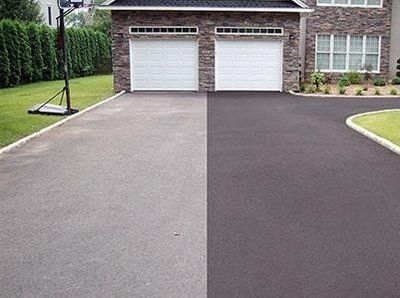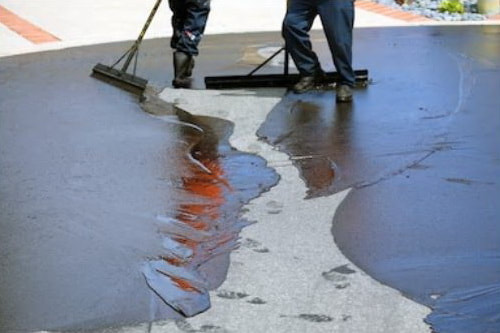Hot Mix Asphalt: A Lasting Service for Pavement
Warm Mix Asphalt (HMA) has actually emerged as a leading lasting choice for sidewalk solutions, using a myriad of cutting-edge innovations and ecological benefits. As the need for green building and construction practices expands, exploring the subtleties of HMA's sustainability can provide beneficial understandings into the future of sidewalk solutions.
Ecological Benefits of Warm Mix Asphalt

Furthermore, Warm Mix Asphalt helps to alleviate city warm island results. Its dark color takes in sunshine, lowering the amount of warmth reflected back into the environment contrasted to lighter-colored sidewalks. This can decrease ambient temperatures in metropolitan locations, reducing the demand for a/c and inevitably reducing energy intake.
In addition, Hot Mix Asphalt adds to boosted stormwater administration. Its permeable nature allows water to infiltrate the pavement and recharge groundwater supplies, decreasing runoff and the danger of flooding. These ecological advantages make Warm Mix Asphalt a lasting selection for leading roadways and freeways.
Power Performance in HMA Manufacturing
Is power efficiency an important consider the manufacturing of Warm Mix Asphalt (HMA)? Absolutely. Power plays a considerable function in the production of HMA, affecting both cost and environmental sustainability. One vital aspect of power effectiveness in HMA manufacturing is making use of warm mix asphalt (WMA) modern technologies (angled parking). WMA permits the mixing and positioning of asphalt at reduced temperatures compared to conventional hot mix asphalt, causing minimized energy intake during manufacturing. This process not just lowers gas use however also lowers greenhouse gas exhausts, making it an extra eco-friendly choice.
Moreover, developments in plant technologies have caused more energy-efficient HMA manufacturing processes. Modern plants are created with attributes like recycled asphalt sidewalk (RAP) processing abilities, efficient heater systems, and improved insulation, all contributing to power savings. By maximizing energy usage in HMA manufacturing, the market can decrease its carbon impact while maintaining top notch pavement products. Energy performance is, as a result, a crucial consideration in ensuring the sustainability of Hot Mix Asphalt manufacturing.
Recyclability of Warm Mix Asphalt
The recyclability of Hot Mix Asphalt (HMA) is a crucial aspect of its sustainability and long-lasting ecological influence. HMA is just one of one of the most recycled products in the United States, with over 100 million tons of recovered asphalt pavement (RAP) being reused yearly in brand-new pavement building. Recycling HMA offers a number of ecological advantages, such as minimizing the demand for virgin products, decreasing power intake during production, and reducing the amount of waste sent to garbage dumps.
The procedure of reusing HMA entails crushing the existing sidewalk, squashing it right into smaller sized pieces, and mixing it with brand-new accumulation and asphalt binder to develop a recycled mix. This recycled mix can often perform as well as and even far better than standard HMA, while needing fewer basic materials and generating reduced greenhouse gas discharges. By integrating RAP into new sidewalk projects, roadway companies can conserve natural deposits, lower prices, and lessen the environmental footprint of road building and construction and upkeep tasks. Generally, the recyclability of HMA plays a substantial function in promoting lasting techniques within the pavement industry.

Long-Term Performance of HMA
Asphalt pavements demonstrate sturdiness and durability over an extensive duration, mirroring the lasting efficiency of Warm Mix Asphalt (HMA) The long life of HMA can be credited to its capability to stand up to hefty web traffic tons, extreme weather conditions, and the effects of aging. Studies have actually revealed that properly designed and appropriately constructed HMA pavements can last for 20 years or even more with normal maintenance. The key to optimizing the long-lasting efficiency of HMA depends on using top quality materials, following best techniques in building and construction, and carrying out efficient maintenance approaches. Correct drainage, routine assessments, and prompt fixings are necessary for preserving the structural stability of HMA pavements with time. Furthermore, innovations in HMA modern technology, such as the usage of polymer-modified binders and warm mix asphalt, have actually even more enhanced the longevity and long life of HMA pavements. By focusing on high quality construction and upkeep practices, HMA remains to prove itself as a cost-effective and sustainable solution for lasting pavement facilities.

HMA: Toughness and Sustainability
Demonstrating both durability and sustainability, Warm Mix Asphalt (HMA) has come to be a foundation in the building and construction of lasting sidewalk facilities - hot mix asphalt. HMA's toughness stems from its capacity to hold up against hefty loads, extreme weather, and high website traffic volumes, making it a reputable choice for roads, highways, and flight terminal paths. The composition of HMA, which normally includes accumulations, binder, and filler, plays an important duty in enhancing its durability and resistance to tear and wear
Furthermore, HMA's sustainability hinges on its recyclability and energy-efficient production process. The capability to recycle reclaimed asphalt pavement (RAP) in new HMA blends lowers the demand for virgin materials and lessens the ecological impact of sidewalk building and upkeep. In addition, the power efficiency of producing HMA depends on its lower mixing temperature levels contrasted to various other sidewalk products, leading to lowered energy usage and greenhouse their website gas discharges.
Verdict
In final thought, warm mix asphalt (HMA) provides a lasting option for sidewalk with its eco-friendly features. HMA's recyclability, energy efficiency in production, and long-lasting toughness make it an eco-friendly choice for roadway construction. By saving natural resources, decreasing waste, and lowering greenhouse gas emissions, HMA plays an essential role in advertising sustainability in framework advancement. Its capability to reduce urban heat island results even more highlights its significance in creating environmentally mindful and durable pavement systems.
HMA is one of the most recycled products in the United States, with over 100 million heaps of reclaimed asphalt pavement (RAP) being reused yearly in brand-new sidewalk building and construction.The procedure of reusing HMA includes crushing the existing pavement, crushing it right see this site into smaller items, and mixing it with brand-new aggregate and asphalt binder to develop a recycled mix.Asphalt pavements show longevity and durability over an extended period, mirroring the long-lasting efficiency of Hot Mix Asphalt (HMA) Furthermore, developments in HMA modern technology, such as the great post to read use of polymer-modified binders and cozy mix asphalt, have actually further enhanced the resilience and longevity of HMA sidewalks. The ability to reuse reclaimed asphalt sidewalk (RAP) in new HMA blends reduces the need for virgin products and reduces the ecological effect of sidewalk construction and maintenance.